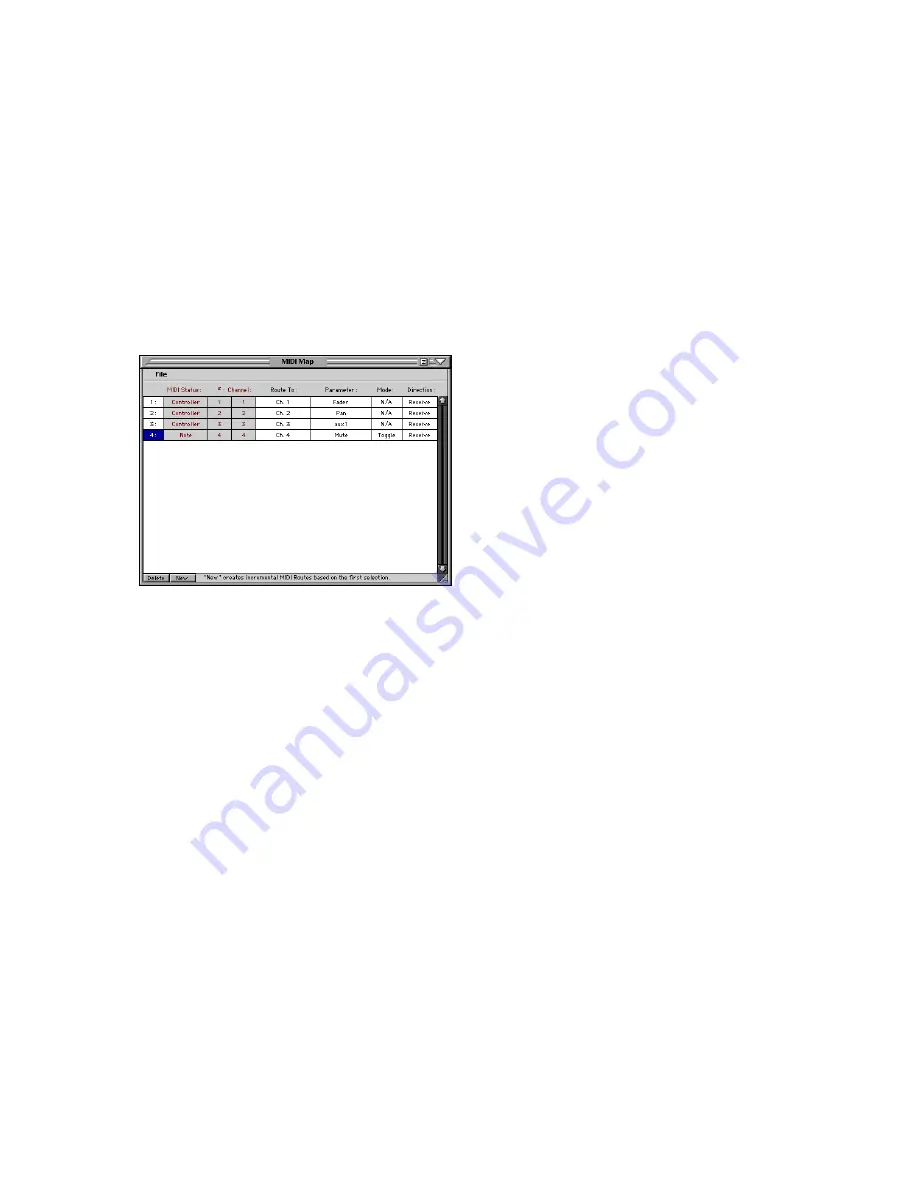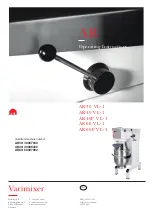
D8B Manual • Chapter 3 • page 85
• If an event is selected in the list, then a change is
made in the Mix Editor, all events following the
selection will be replaced by the new event.
• Use the Undo command from the Edit Menu
(Ctrl+Z) or the control surface to regress through
the mix event steps one at a time.
• Use the Cut or Delete commands from the Edit
Menu (Ctrl+X) to remove all events below the
selected History List event. These actions are not
replaced by Undo or Paste actions.
• Use the Clear Edit History command from the Edit
Menu to remove all events from the History List.
This action cannot be undone.
The MIDI Map Window (Ctrl + –)
The MIDI Map window offers setup options
for bidirectional MIDI control of practically the
entire console’s parameter set. The MIDI Map is a
complete feature revamp from the V2 Channel
List, which consisted only of channel fader, mute,
and pan MIDI routing. The V3 MIDI Map provides
complete parameter access to channel functions,
master fader, channel strip, and Aux master
controls, and all plug-in parameters. In addition,
the Master section and Transport controls are
assignable to MIDI messages. Additionally, a
‘roving ’ Fat channel map routing may be added,
so that MIDI control may follow the selected Fat
Channel, which is great for external devices such
as a joy stick or X-Y pad controlling (for example)
a channel’s Surround Pan without hard mapping
(and subsequent remapping). MIDI Maps may be
created and saved to disk for subsequent recall.
MIDI continuous controller, polyphonic
aftertouch, and note on messages are assigned to
the various parameters via the MIDI Map, in a
linear approach of one controller type per param-
eter. In V2, mapping was limited to fader control
as continuous controller messages, mutes as note
on and off messages, and pan as polyphonic
aftertouch control messages. In V3, any variable
controller may be a continuous control message or
a poly aftertouch message, and any switch mes-
sage (on/off or assignment switches) can be
assigned to a note on (or note off as note on of
velocity 0) message.
In V2, messaging was selectable as In (re-
ceive) or Out (send) but not both, whereas in V3
messaging may be bidirectional. This means you
can control the console from a sequencer or
control a sequencer from the console. Note that
MIDI program changes may also be used to
trigger D8B snapshots. Snapshot program change
messages may occur simultaneously with MIDI
Map control messaging. The shorter length MIDI
program change messages allow for much greater
MIDI bandwidth utilization, and in some cases can
accomplish the required control without totally
mapping the console via the MIDI Map. Snapshot
triggering via MIDI is not enabled in the MIDI
Map, but is set via the GUI Setup>Mix Options
window, by checking the MIDI Snapshot box.
A listing of D8B console parameters is found
in the MIDI Implementation Chart at the end of
this document. The off, minimum, and maximum
values are listed with the associated MIDI control-
ler values to aid in setting up a remote control
map. Note that many of the console’s values are
8-bit resolution (255 values). Since MIDI conven-
tionally sends only 128 values (two byte MSB/LSB
precision is not supported by the D8B), intermedi-
ate steps will be interpolated by the D8B.
Applications for the MIDI Map include remote
transport control from MIDI applications that
don’t support MMC (but do allow their own
internal parameter mapping), surround joystick
control, or any continuous controller or two-state
switch application (lighting, remote mixing, show
controls, etc.). Any mapped control information
may be transmitted via manual adjustment on the
console, snapshot recall, and/or automation
playback (which may include snapshot or other
Event track playback).
Creating a Route
A Route is created by opening the MIDI Map
from the Windows menu, then selecting “New
MIDI Route” from the MIDI Map File menu or
simply clicking the NEW button at the bottom of
the MIDI Map screen. A Route is made up of the
following attributes:
• (Selection): The first column (with no column
header) denotes the Route number and selected
Route within the map list. The number is a simple
identifier, as there is no sorting mechanism for the
MIDI Routes. The selection paradigm is the same
for any D8B listing function; Shift-click allows for
multiple selections and Ctrl-click allows for
discontinuous selections.
• MIDI Status: This choice offers the type of MIDI
message (as XNh, where X is the status type, N is
the MIDI channel, and h denotes that it’s listed in
hexadecimal values). If the Route is mapping a
switch parameter with two value states, it will be
Summary of Contents for D8B 3.0
Page 8: ...D8B Manual Preface page 2 ...
Page 9: ...D8B Manual Chapter 1 page 3 Chapter 1 Getting Ready ...
Page 27: ...D8B Manual Chapter 2 page 21 Chapter 2 Where Is It ...
Page 47: ...D8B Manual Chapter 3 page 41 Chapter 3 What s On TV ...
Page 93: ...D8B Manual Chapter 4 page 87 Chapter 4 Applications ...
















































